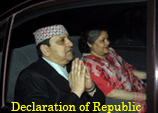Birth of Communism in Nepal
The development of democracy, nationalism, socialism, and communism in Nepal got started just about sixty years ago. In the year 2003 B.S, Nepali Congress was established where in a small fraction led by Pushpalal Shrestha got detached with the party in 2006 B.S and came forward establishing a communist party in Nepal which is believed to the first communist party in Nepal. The communist party joined hand in hand with Nepali Congress to fight against the dictatorial regime of the Rana in 2007 B.S. Immediately after the revolution was over, there was a tri-party agreement held between Nepali Congress, King Tribhuwan and Rana Family. The communist party believed this agreement to be a betrayal to Nepalese people and tried some small movement against the then government.
It was only when King Mahendra made an attempt to band all the parties in Nepal and established a party less democracy in 2017 B.S that the left fraction led by Pushpalal and Manamohan Adhikari joined hands with NC for the restoration of democracy. Some small communist fraction was believed to support the then step of king Mahendra in 2017 B.S. Pushpalal Shrestha, Mohan Bikram Singh, Nirmal Lama and Manamohan Adhikari were against the king’s act. These leaders staying in India started creating a broader alliance against the king’s regime. In 1971, Mainali was one of a group of young leaders of the Jhapa District Committee of the Communist Party of Nepal. The other main leaders of this group were Radha Krishna Mainali, Mainali's brother, and Mohan Chandra Adhikari. The group was inspired by the Naxalbari rebellion in India and its leader Charu Majumdar. In May 1971, the group initiated an armed rebellion, killing landlords and other perceived class enemies. This took place under the leadership of C.P Manaili, Radhakrishna Mainali, Manamohan Adhikari and other leaders including Ramnath Dahal. This incident even today, remains as a dirty patch for CPN (UML).
The Patna plenum which took place in 2018 B.S in Patna divided the communist party of Nepal into two fractions, one of which joined hands with the king supporting the new system whilst others remaining against it. Communist leaders were divided into so many fractions called Pushpalal, Marxist, Marxist-Leninist, Fourth Convention, Unity Centre, Workers-Proletarian, Rohit, Marxist-Leninist-Maoist, Mashal, Masal, Manandhar, and Burma who differed in the type of Communism to be practiced in Nepal. In 2035 B.S, Marxist-Leninist was established.
In 2039, after the death of political leader B.P Koirala, there was a continuous polarization in the Communist movement of Nepal. The followers of Pushpalal fraction got united with the fraction led by Manamohan Adhikari blaming Pushpalal being in the favor of Nepali Congress. The Satyagraha movement in 2042 was only supported by Manamohan-Sahana fraction with all the other communist fractions remaining against it.
But in 2046 B.S, the Communist fraction led by Prachanda was the only communist fraction which opposed itself from the movement. All the other Communist fractions came forward forming a Left Alliance comprising of nine small fractions. At first the alliance decided supporting the movement declared by NC, verbally after which it got involved in the movement.
Immediately after the successful accomplishment of people’s movement in 1990 A.D, a small group led by Pushpa Kamal Dahal got detached from the Communist party of Nepal (Unity Centre). This fraction also established an electoral front named United People’s Front (Samyukta Janamorcha) led by Dr. Baburam Bhattarai. In 2046, Chaitra 26th, the Panchayat Regime was ousted and a government under Krishna Prasad Bhattarai comprising of NC, Royal Palace and United Left Front was formed. After which a Constituent Drafting Commission comprising of all the party, was formed under the leadership of Bishwanath Upadhyaya. The constituent formed by this Commission incorporated Constitutional-Monarchy, Multi-party system, Hindu-Kingdom, Sovereignty under Nepalese people as it’s basics.
Except Communist Party of Nepal (Masal), all the other communist fraction including the electoral front of the communist party led by Pushpa Kamal Dahal, United People’s Front involved itself in the parliamentary election. CPN (Marxist), led by Manamohan Adhikari dissolved itself with CPN (Marxist-Leninist) forming CPN (United Marxist-Leninist). The newly formed CPN (UML) won majority of the seats numbered 60, United People’s Front won 9 seats and other communist fractions won a total number of 5 seats in the parliamentary election. The Font led by Dr. Baburam Bhattarai and the Communist party of Nepal led by Pushpa Kamal Dahal got united and declared a People’s War. On the other hand, CPN (UML) formed a government in 2051 B.S and after which it also joined the government led by Lokemdra Bahadur Chand, a well-known royalist. The Workers-Proletarian party led by Ruplal Bishwakarma was dissolved after which the leader was completely away from the Left politics in Nepal.
On today’s date, Unified Communist party of Nepal (Maoist) is the largest political party in Nepal and also the largest left party in Nepal. It won a majority of 120 seats in the CA election in first-past-the-post system and collected itself with 229 numbers. But recently in 2009, 12th of January, this party has united with another left party, Communist party of Nepal (Unity-Centre-Masal) which had won a total of 8 seats in the CA election. This has increased the parliamentary strength of this party to 237 seats in total. The second largest left party of Nepal happens to be Communist party of Nepal (Unified Marxist-Leninist) which is the third largest party of Nepal. It won a total of 37 seats in the Constituent Assembly election in the first-past-the-post system where in the election was for a total of 240 seats. It has secured a total of 115 seats in CA.





